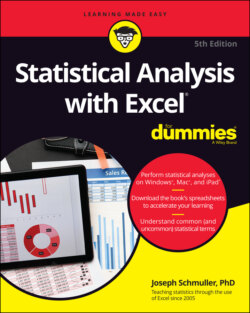Читать книгу Statistical Analysis with Excel For Dummies - Joseph Schmuller - Страница 40
Why Use Graphs?
ОглавлениеSuppose you have to make a pitch to a Congressional committee about commercial space revenues in the early 1990s.
Which would you rather present: the data in Table 3-1 or the graph in Figure 3-1, which shows the same data? (The data, by the way, is from the US Department of Commerce, via the Statistical Abstract of the US.)
TABLE 3-1 US Commercial Space Revenues 1990–1994 (in Millions of Dollars)
| Industry | 1990 | 1991 | 1992 | 1993 | 1994 |
|---|---|---|---|---|---|
| Commercial Satellites Delivered | 1,000 | 1,300 | 1,300 | 1,100 | 1,400 |
| Satellite Services | 800 | 1,200 | 1,500 | 1,850 | 2,330 |
| Satellite Ground Equipment | 860 | 1,300 | 1,400 | 1,600 | 1,970 |
| Commercial Launches | 570 | 380 | 450 | 465 | 580 |
| Remote Sensing Data | 155 | 190 | 210 | 250 | 300 |
| Commercial R&D Infrastructure | 0 | 0 | 0 | 30 | 60 |
| Total | 3,385 | 4,370 | 4,860 | 5,295 | 6,640 |
Data from U.S. Department of Commerce
FIGURE 3-1: Graphing the data in Table 3-1.
Which one would have a greater and more lasting impact? Although the table is certainly informative, most people would argue that the graph gets the point across better and more memorably. (Eyes that glaze over when looking at numbers often shine brighter when looking at pictures.)
The graph shows you trends you might not see as quickly on the table. (Satellite services rose fastest. Commercial launches, not so much.) Bottom line: Tables are good; graphs are better.
Graphs help bring concepts to life that might otherwise be difficult to understand. In fact, I do that throughout the book. I illustrate points by, well, illustrating points!
